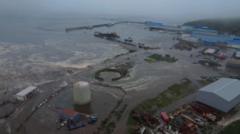The Pacific was set on high alert after a massive earthquake measuring 8.8 struck off Russia's eastern coast near the Kamchatka Peninsula, around 11:25am local time on Wednesday. This quake is noted as one of the strongest ever recorded, causing immediate tsunami warnings in several countries, including Russia, Japan, and parts of the US west coast.
In Japan, about 1.9 million residents were urged to seek higher ground as mega waves were forecasted. Videos from Russia's Severo-Kurilsk displayed frightening scenes of waves overwhelming buildings, with authorities reporting significant flooding and disruption to local infrastructure, including a power grid in Sakhalin.
The situation is evolving as tsunami waves ripple across the Pacific. While predictions remain uncertain, scientists are working to model the disaster’s potential impacts, which could vary dramatically by location. Energy projected southeast from Kamchatka may result in serious effects for certain areas.
In Hawaii, officials alerted citizens that waves could reach up to 10 feet, although no large waves had been recorded yet. Time estimates suggest it could take around eight to nine hours for tsunami waves from Russia to reach the US coast, with initial impacts expected in British Columbia and California by 12:20am local time.
The earthquake was at a depth of 19.3 km and initially classified as 8.0 but later updated to 8.8. It ranks as one of the strongest earthquakes globally, tied for sixth place in severity. Comparisons have been drawn to historical quakes, including the infamous 2004 Indian Ocean disaster that resulted in devastating consequences. As predictions span across the Pacific, communities remain on high alert and ready for potential evacuations.
In Japan, about 1.9 million residents were urged to seek higher ground as mega waves were forecasted. Videos from Russia's Severo-Kurilsk displayed frightening scenes of waves overwhelming buildings, with authorities reporting significant flooding and disruption to local infrastructure, including a power grid in Sakhalin.
The situation is evolving as tsunami waves ripple across the Pacific. While predictions remain uncertain, scientists are working to model the disaster’s potential impacts, which could vary dramatically by location. Energy projected southeast from Kamchatka may result in serious effects for certain areas.
In Hawaii, officials alerted citizens that waves could reach up to 10 feet, although no large waves had been recorded yet. Time estimates suggest it could take around eight to nine hours for tsunami waves from Russia to reach the US coast, with initial impacts expected in British Columbia and California by 12:20am local time.
The earthquake was at a depth of 19.3 km and initially classified as 8.0 but later updated to 8.8. It ranks as one of the strongest earthquakes globally, tied for sixth place in severity. Comparisons have been drawn to historical quakes, including the infamous 2004 Indian Ocean disaster that resulted in devastating consequences. As predictions span across the Pacific, communities remain on high alert and ready for potential evacuations.


















